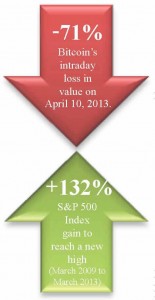Bitcoin is a new form of money. It is 100 percent electronic and it just exploded in popularity. In just 6 weeks a Bitcoin went from $25 to $250. What an exciting time for Bitcoin speculators. Why even question it? This is a new electronic age and the possibilities are endless.
Not so fast! On April 10, 2013, the Bitcoin imploded. In just a few hours the value of a Bitcoin fell from $266 to $76.
What is the problem with Bitcoins? Where do we begin? The synthetic currency has no intrinsic value. It represents ownership of nothing. It is not backed by any government. It is not a commonly accepted form of payment. Its owners could be hacked and robbed, or it could be replaced by a more popular made-up currency. The Bitcoin mania may turn out to be one of the most spectacular bubbles of all time.
The term bubble was first used in the early 1700s to refer to wild price fluctuations associated with the “South Sea Bubble.” Another famous episode was the Dutch tulip mania of 1637. In recent history, we have survived the dot com bubble, the real estate bubble, the oil bubble, and possibly the gold bubble.
Why are we so prone to pricing bubbles? Will they ever end?
Greed: The idea that $100 could turn into $150 tomorrow creates fans. That excitement leads them to forget that it is one of the most volatile ways to gamble. Given that it has no real value, it may be more likely to fall 50 percent than rise 50 percent.
Conformity: When opinions converge on an incorrect idea, we call it groupthink or herd mentality. When money is involved, we call these bubbles, and they are dangerous because they can be costly.What should we watch for when trying to detect a bubble?
(1) Insane predictions (with or without good explanation)
(2) Excessive attention as too many people discuss and act like experts
(3) Repeated use of the phrase “this time is different”
(4) Deviation from normal supply and demand because of manipulation
The U.S. stock market has had a string of new highs over the last few months. This in and of itself is no cause for alarm. Hitting new highs is exactly what stocks are supposed to do. That is how investors make money. (Read “Patience is a Rewarding Virtue” from the previous issue of the Money Moxie.)
How do we know if stocks are in the process of forming a bubble? There are a few simple reasons why investors should not be overly concerned at this point.
(1) Stocks represent ownership of real companies that have value and can grow in value
(2) Valuations of companies compared to earnings are near historical averages
(3) Fundamental improvements in the economy are taking place that support a rise in the market
Bubbles involve a high degree of risk. One way to avoid unnecessary risk is to watch out for investments that don’t have real value or have deviated too far from their true value. Those values are derived from how much the next person is willing to pay.
On the other hand, stocks market gains can benefit everyone who participates. Stocks represent ownership of something real. Time has shown that carefully investing in a diversified portfolio can yield positive results over time.




